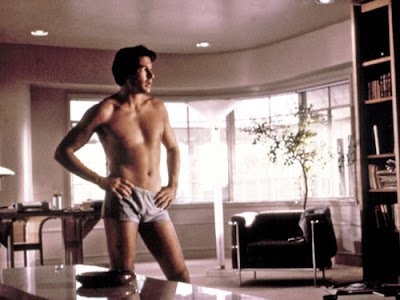The leather subculture denotes practices and styles of dress
organized around sexual activities. Wearing
leather garments is one way that participants in this culture self-consciously
distinguish themselves from mainstream sexual cultures. Leather culture is most visible in gay
communities and most often associated with gay men ("leathermen"),
but it is also reflected in various ways in the gay, lesbian, bisexual, and
straight worlds. Many people associate
leather culture with BDSM (Bondage/Discipline, Dominance/Submission,
Sado/Masochism, also called "SM" or "S&M") practices
and its many subcultures. But for
others, wearing black leather clothing is an erotic fashion that expresses
heightened masculinity or the appropriation of sexual power; love of
motorcycles and independence; and/or engagement in sexual kink or leather
fetishism.
Gay male leather culture has existed since the late 1940s,
when it likely grew out of post-WWII biker culture. Early gay leather bars were subcultural
versions of the motorcycle club with pioneering gay motorcycle clubs including the
Satyrs, established in Los Angeles in 1954; Oedipus, also established in Los
Angeles in 1958, and the New York Motorbike Club. Early San Francisco clubs included the
Warlocks and the California Motor Club.
Leather clubs for gay men started in Amsterdam and Berlin in the 1950s.
These gay clubs, like the clubs of straight motorcycle
culture in general, reflected a disaffection with the mainstream culture of
post-World War II America, a disaffection whose notoriety — and therefore
appeal — expanded after the sensationalized news coverage of the Hollister
"riot" of 1947. The 1953 film The Wild One starring Marlon Brando
wearing jeans, a T-shirt, a leather jacket, and Muir cap, played on
pop-cultural fascination with the Hollister "riot" and promoted an
image of masculine independence that resonated with some gay men who were
dissatisfied with a culture that stereotyped gay men as effeminate. To that end, gay motorcycle culture also
reflected some men's disaffection with the coexistent gay cultures more organized
around high culture, popular culture (especially musical theater), and/or camp
style. Perhaps as a result, the leather
community that emerged from the motorcycle clubs also became the practical and
symbolic location for gay men's open exploration of kink and S&M.
Throughout the history of the leather subculture, a variety
of traditions have been observed, often diligently. While most or all are based on military
protocols and ritual, these traditions varied widely between regions, causing
much debate today over which traditions are the "original" or
"true" traditions, or whether the "romanticized versions of
leather history" ever existed at all.
As time has progressed and BDSM has become more mainstream,
the traditions of leather has adapted. The first major evolution has become
known as "New Leather" or "New Guard". However, even this is the subject of some
disagreement, as many noted authors and historians assert that there is little
or no substantive differences.
Today, the leather subculture is one of many facets to
semi-organized alternative sexuality.
Many individuals describe long periods of introspection leading to their
choice to identify as "leather".
Others do not necessarily associate their leather lifestyle with BDSM,
and simply enjoy the sensory experience of leather.
The more specifically homoerotic aesthetics of men's leather
culture drew on other sources as well, including military and police
uniforms. This influence is particularly
evident in the graphical illustrations of leathermen found in the work of Tom
of Finland. The pornographic films of
one of his models Peter Berlin from Berlin, such as his 1973 film Nights in Black Leather, also reflected
and promoted the leather subcultural aesthetic.
In the 1970s Berlin had a huge leather scene with several leather clubs
in the gay area around Nollendorfplatz.
In 1975 Europe's biggest gay fetish event started, Easter in Berlin
Leather Festival.
Aspects of leather culture beyond the sartorial can also be
seen in the 1970 murder mystery novel Cruising
by Jay Green. The novel was the basis for the 1980 movie of the same name
starring Al Pacino, which depicted aspects of the men's leather subculture for
a wider audience.
Rob Halford, the lead singer of heavy metal band Judas
Priest, openly identifies as gay and wears black leather. And lastly, perhaps no figure has more
vividly represented the leather subculture in the popular imagination than the
leatherman portrayed by Glenn Hughes of the Village People.
Numerous major cities host Leather Pride events, including
San Francisco's Folsom Street Fair, Berlin's Easter in Berlin Leather Festival
(Europe's biggest gay fetish event) from 1975 and Folsom Europe, New York
City's Folsom Street East, Chicago's International Mr. Leather (the title is
currently held by Andy Cross of San Francisco, pictured below) and Amsterdam's
Leather Pride. The 10,000-square-foot,
two-story Leather Archives and Museum, based in Chicago, has much information
and details on the beginning of the leather subculture.
In addition to activities in Chicago, the LA&M serves
the leather world by preserving material from various leather communities, and
sends traveling exhibits around the country.
In 2005, Viola Johnson started traveling with The Carter-Johnson Leather
Library (
http://www.leatherlibrary.org)
and telling self-promoting stories from her 35 years of personal involvement in
the leather subculture.
Now … if only I could get Tom into leather ….



















































